|
"Those who expect to reap the blessings of freedom must...undergo the fatigue of supporting it." --Thomas Paine: The American Crisis, No. 4, 1777 On this Memorial Day, I am thankful that the closest I have ever come to experiencing life in a war zone is by reading about it or listening to the oral histories of World War II and Vietnam veterans. And so a list of books, including straightforward nonfiction and memoir, that can begin to make that which is incomprehensible -- the personal experience of war -- understandable. 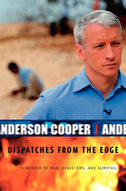 Dispatches From The Edge Anderson Cooper (2007) The correspondent and anchor for CNN recounts events from his life and career, offering a behind-the-scenes look at some of the most devastating modern tragedies (in Burma, Vietnam, and Somalia) and their effect on his own life. 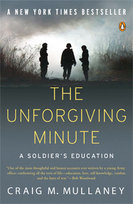 The Unforgiving Minutes: a soldier's education Craig Mullaney (2009) From a blue-collar upbringing, Mullaney rose to graduate from West Point, became a Rhodes scholar, and then an Army Ranger. He takes an unflinching look at the ways in which his extensive military education did and did not prepare him for his experiences in Afghanistan, and how those experiences shaped his views, and his later work as a Naval Academy instructor.  Requiem: by the photographers who died in Vietnam and Indochina (1997) A photographic essay that takes readers on an emotional journey into the wars in Indochina, Cambodia, Vietnam, and Laos. Divided into five sections, the book begins with the early notions of the wars, continues through the escalation, and ends with the final days of the conflicts. Essays are included on some of the photographers, providing readers with a glimpse into the lives of these brave men and women. The photographers' accounts of the fighting provided to various news wires are also included, but the photographs are so poignant and moving that they virtually tell the stories on their own.  The Forever War Dexter Filkins (2008) The New York Times correspondent provides a firsthand account of the battle against Islamic fundamentalism, from the rise of the Taliban in the 1990s, to the terrorist attacks of 9/11, to the wars in Afghanistan and Iraq, offering a study of the people involved from all sides of the conflict. 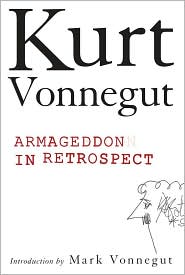 Armageddon in Retrospect Kurt Vonnegut (2008) Twelve previously unpublished writings on war and peace include such pieces as an essay on the destruction of Dresden, a story about the first-meal fantasies of three soldiers, and a meditation on the impossibility of shielding children from the temptations of violence. 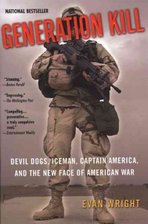 Generation Kill: Devil Dogs, Iceman, Captain America, and the new face of American war Evan Wright (2004) Wright rode into Iraq on March 20, 2003, with a platoon of First Reconnaissance Battalion Marines—the Marine Corps' special operations unit whose motto is "Swift, Silent, Deadly." He writes a gripping narrative on the lives of these twenty-three soldiers who led the attack, describing their training and the physical and psychological challenges they faced in skirmishes leading to the fall of Baghdad. 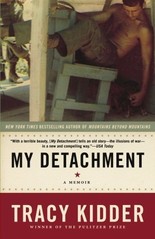 My Detachment Tracy Kidder (2005) Pulitzer Prize winner Kidder (The Soul of a New Machine) uses his gift for narrative nonfiction in this memoir of his year in Vietnam as a young army officer. This isn't a blood-and-guts thriller, but a story of painful self-revelation and amusing coming of age. He joined the ROTC as a confused Harvard student and ended up in a not very dangerous corner of Vietnam monitoring radio patterns. His attempts to command his detachment of bored enlisted men and his letters home, laced with fictional heroics, could have been the stuff of melodrama, but Kidder's storytelling and humor rise above. His account is an introspective, demythologizing dose of reality seen through the eyes of a perceptive, though immature, army intelligence lieutenant at a rear-area base camp. War isn't hell here; it's "an abstraction, dots on a map." A little levity is just the thing to lighten up a commencement ceremony: Let's face it -- graduation ceremonies can be long, drawn-out, boring, sweaty affairs in which cap-and-gown clad adolescents or young adults and their family members squat on uncomfortable folding chairs in stuffy fieldhouses or under the hot, scorching sun for hours, listening to fairly mundane speechifying and a long list of names before having their ten seconds in the spotlight, during which they hope and pray that they (or their loved ones) don't do something mortifying like stumbling across the stage (graduates) or blowing an airhorn or ringing cowbells (family members) simply because the student actually managed to graduate from high school (or college). Yo, really??? You don't need to do The Wave because your baby got his or her diploma. It's not that much of an achievement in 2012.  One of those people who peaked in high school... Part of the problem is the commencement address. Most are trite, repetitive and not written in especially soaring language that transcends space and time. (And I admit, neither is this blog -- but that's entirely beside the point.) What if commencement addresses could be distilled to their essence so that we got the message without all the repetitious medium, saving us hours of our precious lives and sweat?  Sea of sweating graduates They might sound something like this: "Find your passion. Believe in yourself. Do not let others define who you are. Have big dreams. Follow your heart and your intuition. Take action and get in the game. Do what you love. Be bold and courageous. Use your imagination and creativity. You do not need to be perfect. It's okay to fail. Do not give up. Live in the present moment. Think that you can do it. Take risks. Embrace change. Work hard, play hard and keep walking the path. Maintain your integrity. Give back. Keep learning." There you go. All the wisdom of the world packed into two minutes or less (depending on how fast you talk)! Leaving the extended family much more time to sit around the kitchen or patio, arguing about politics, religion or whether the viewers who actually vote for "American Idol" contestants are biased in favor of WGWGs (white guys with guitars). Because it appears that some people actually care about such things. "American Idol," that is. And they presumbly graduated from high school. So 'nuff said about that achievement.
 Chicago Tribune columnist and Pulitzer Prize winner: Mary Schmich (In which we look at famous graduation addresses of the past) This one filed under "Wish I'd Written That" By Mary Schmich, one of my heroes: Wear sunscreen. If I could offer you only one tip for the future, sunscreen would be it. The long-term benefits of sunscreen have been proved by scientists, whereas the rest of my advice has no basis more reliable than my own meandering experience. I will dispense this advice now. Enjoy the power and beauty of your youth. Oh, never mind. You will not understand the power and beauty of your youth until they've faded. But trust me, in 20 years, you'll look back at photos of yourself and recall in a way you can't grasp now how much possibility lay before you and how fabulous you really looked. You are not as fat as you imagine. Don't worry about the future. Or worry, but know that worrying is as effective as trying to solve an algebra equation by chewing bubble gum. The real troubles in your life are apt to be things that never crossed your worried mind, the kind that blindside you at 4 p.m. on some idle Tuesday.  Do one thing every day that scares you. Sing. Don't be reckless with other people's hearts. Don't put up with people who are reckless with yours. Floss. Don't waste your time on jealousy. Sometimes you're ahead, sometimes you're behind. The race is long and, in the end, it's only with yourself. Remember compliments you receive. Forget the insults. If you succeed in doing this, tell me how. Keep your old love letters. Throw away your old bank statements. (but first, learn more about how to Reduce, Reuse, Recycle ) Stretch. 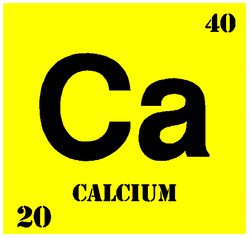 Don't feel guilty if you don't know what you want to do with your life. The most interesting people I know didn't know at 22 what they wanted to do with their lives. Some of the most interesting 40-year-olds I know still don't. Get plenty of calcium. Be kind to your knees. You'll miss them when they're gone. Maybe you'll marry, maybe you won't. Maybe you'll have children, maybe you won't. Maybe you'll divorce at 40, maybe you'll dance the funky chicken on your 75th wedding anniversary. Whatever you do, don't congratulate yourself too much, or berate yourself either. Your choices are half chance. So are everybody else's. Enjoy your body. Use it every way you can. Don't be afraid of it or of what other people think of it. It's the greatest instrument you'll ever own. 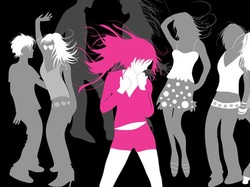 Dance, even if you have nowhere to do it but your living room. Read the directions, even if you don't follow them. Do not read beauty magazines. They will only make you feel ugly. Get to know your parents. You never know when they'll be gone for good. Be nice to your siblings. They're your best link to your past and the people most likely to stick with you in the future. Understand that friends come and go, but with a precious few you should hold on. Work hard to bridge the gaps in geography and lifestyle, because the older you get, the more you need the people who knew you when you were young. Live in New York City once, but leave before it makes you hard. Live in Northern California once, but leave before it makes you soft. Travel. 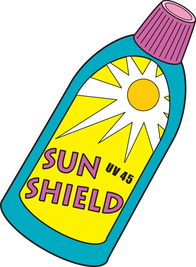 Accept certain inalienable truths: Prices will rise. Politicians will philander. You, too, will get old. And when you do, you'll fantasize that when you were young prices were reasonable, politicians were noble and children respected their elders. Respect your elders. Don't expect anyone else to support you. Maybe you have a trust fund. Maybe you'll have a wealthy spouse. But you never know when either one might run out. Don't mess too much with your hair or by the time you're 40 it will look 85. Be careful whose advice you buy, but be patient with those who supply it. Advice is a form of nostalgia. Dispensing it is a way of fishing the past from the disposal, wiping it off, painting over the ugly parts and recycling it for more than it's worth. But trust me on the sunscreen. so I turn to Youtube and a video. I challenge you to watch this and not crack up! I don't know how the young man did this without busting a gut!
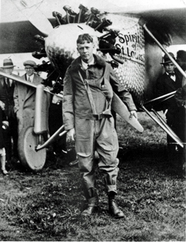 On May 20, 1927, Charles Lindbergh took off from Roosevelt Airfield on Long Island, New York, aboard the Spirit of St. Louis, the custom-built, single engine, single-seat monoplane, on his historic solo flight to France. 33 hours, 30 minutes later he landed at Aéroport Le Bourget in Paris, France, a distance of about 3,600 miles.  Read more about it: The Flight of the Century (Thomas Kessner, 2010) In 1927 an inexperienced and humble 25-year-old Air Mail pilot from Minnesota stunned the world by making the first non-stop transatlantic flight. A spectacular triumph of individual daring and collective technological accomplishment, Charles Lindbergh's flight from New York to Paris ushered in the age of commercial aviation. Kessner takes a look at one of America's greatest moments, examining how what was essentially a publicity stunt became a turning point in history. He vividly recreates the flight itself and the euphoria that greeted the achievement on both sides of the Atlantic. He makes the case that Lindbergh's feat occurred just when the world--still struggling with the disillusionment of WWI--desperately needed a hero to restore a sense of optimism and possibility. 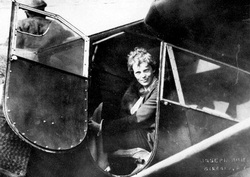 Just five years later, on May 20, 1932, Amelia Earhart took off from Harbor Grace, Newfoundland in her Lockheed Vega nicknamed "Little Red Bus," on her flight to Paris, hoping to duplicate Lindbergh's achievement and become the first woman to fly solo across the Atlantic Ocean. Strong north winds pushed her off course, and icy conditions and mechanical problems plagued the flight, forcing her to land in a pasture near Londonderry, Ireland. But she had indeed crossed the Atlantic. 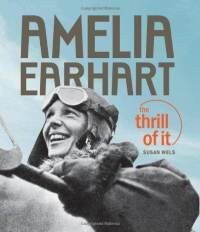 Read more about it: Amelia Earhart: The Thrill of It (Susan Wels, 2009) America’s record-breaking aviatrix pursued her passions, broke gender barriers, and inspired generations of women to take to the skies. Wels writes a brisk narrative which hits all the main points and captures the can-do spirit of Earhart.  Boeing 314 - California Clipper (courtesy aviationhistory.com) Seven years later, on May 20, 1939, Pan American Airways inaugurated the first transatlantic mail service. Under the command of Captain A. E. LaPorte, a Boeing 314 Clipper carried almost a ton of mail from Port Washington to Marseilles, via the Azores and Lisbon in 29 hours. 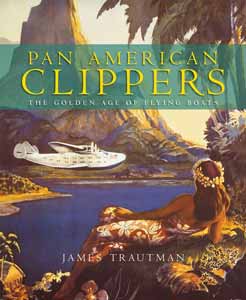 Read more about it: Pan American Clippers: The Golden Age of Flying Boats ( James Trautman, 2011) For the world struggling to emerge from the economic turmoil of the 1930s, the Pan American Airways Clipper "flying boats" symbolized elegance, adventure and romance. This fascinating book, illustrated with photographs, travel posters, magazine ads and company brochures, brings to life every aspect of the fabulous era of Pan American's clippers. Like their sea-going namesakes, Clippers used the oceans to form a global network of travel routes. Pan Am founder Juan Trippe envisioned the importance of international travel to a changing world. His Clippers played a key role in the evolution of transoceanic flight, setting time and distance records over the Atlantic and Pacific, providing airmail delivery between continents and eventually serving the Allies as troop and cargo transports during World War II. High Flight
Oh! I have slipped the surly bonds of earth, And danced the skies on laughter-silvered wings; Sunward I've climbed, and joined the tumbling mirth Of sun-split clouds, --and done a hundred things You have not dreamed of --Wheeled and soared and swung High in the sunlit silence. Hov'ring there I've chased the shouting wind along, and flung My eager craft through footless halls of air... Up, up the long, delirious, burning blue I've topped the wind-swept heights with easy grace Where never lark or even eagle flew -- And, while with silent lifting mind I've trod The high untrespassed sanctity of space, Put out my hand, and touched the face of God. --- John Gillespie Magee, Jr. America was founded on this principle: the pursuit of happiness. Of course, the operative word here is "pursuit." No guarantees. But technology, in the form of the smartphone, has stepped up to help us in the chase. Texting, tweeting, playing Words With Friends or Angry Birds, and maybe, just maybe, making the occasional old-fashioned person-to-person call: it’s all in a day’s work for the typical Smartphone. But did you know that they soon may replace your therapist as well? Hey, we all want to be stress-free (or at least stress-reduced) happy campers who are in tune with our feelings at any moment of the day or night, right?!? 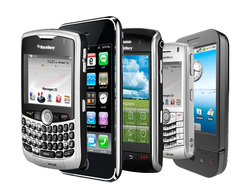 Well, lo-and-behold, there is an app to help you with that. Numerous apps. (And by the time you read this, probably a few more.) And best of all, they are all either free or a lot cheaper than a session on a psychiatrist’s couch. So grab your phone and download nirvana (or an approximation of it). 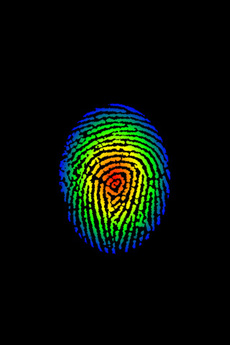 2012 equivalent of a mood ring: Mood Finger Scan Moody Blues Not sure what mood you are in right now? Remember those Mood Rings from the mid- 70's (the first Me Decade)? You’d wear one and the stone would turn a certain color depending on how your were feeling: black for stressed and nervous, blue for calm and collected, green for “normal” (whatever that means). Well, now there are Mood Apps like Mood Scanner (Android) and Mood Finger Scan (iPhone). Just scan an available body part (I’m talking fingers or thumbs here) and the app will report your present emotional conditions. Judging by the customer reviews, these apps work as well as the original Mood Rings! (But hey, at least they’re free!) 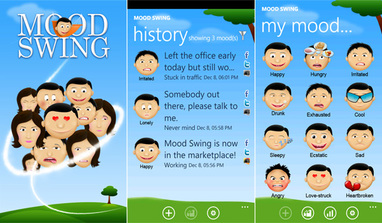 Mood Swing app If you are really into over-analyzing every breath you take (and every emotional move you make), perhaps a “mood-minder” app is just the thing for you. These apps require that you check in at least once a day (or once an hour, or every fifteen minutes depending on how neurotic you are) to record your mood and whatever is happening in your life at that moment that might be influencing that mood. The app will analyze your data and present you with an infographic of charts and calendars that give you an overview of your every emotional high and low: who’s bringing you down, what picks you back up, and any place that might be your personal valley of the shadow. These apps include Mood Swing, which lets you track your mood with “beautiful expressions and mood images” (cartoon faces smiling, frowning, staring wistfully) and share your current mood on both Facebook and Twitter. (Of course! Because if you don’t share your mood swing with 180 of your friends, it didn’t really happen.)  Mood panda app MoodPanda has similar features, but longer hair ---oops, no --- a cute Panda to accompany the infographics. Then there’s Moody Me which purports that “you will have more happy days” if you use it. This app allows you to create a slideshow of pictures of people, places or things that make you happy. Then you can play it whenever you need “an instant lift.”  Live Happy screenshots A Psychologist at your Fingertips Who has time to visit a therapist these days? And who really wants to talk to another human being about her... issues? Especially when you can consult a therapist in the palm of your hand. Therapy apps purport to teach you cognitive and behavioral strategies to cope with your problems. Live Happy bills itself as a “happiness boosting positive psychology program,” based on research by Dr. Sonja Lyubomirsky, professor of psychology at the University of California and author of The How of Happiness. Among the “get happy” activities that it offers are a prompt for remembering happy days, a reminder to savor the moment (take a photo of your special person, place or thing and enter a brief note as to why you value it), and a kindness journal. 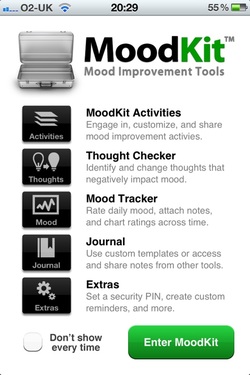 MoodKit app Mood Kit also provides activities to improve your mood in a variety of life categories: productivity, physical fitness, health habits, your participation in the social scene, etc. It also includes a “thought checker” to help you weed out all that negativity that might creep in at 3 am during one of those long, dark nights of the soul, when you've been left dateless with just a quart of Oberweis Udderly Truffles ice cream to console you. 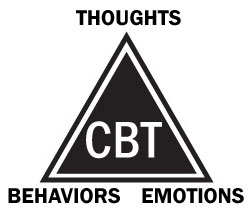 A couple of apps feature the use of Cognitive Behavioral Therapy, which works on the theory that we think thoughts all the time and some thoughts can have a big impact on our mood. (Duh!!!) By writing down our thoughts and studying them, we can train our brains to react differently in the future. By identifying forms of "bad thinking" are these thoughts, you become an expert at how your brain is affecting your mood. Often it's not your actual life situation that's causing the depression, it's those constant negative thoughts about the situation. (The psych term is “perseveration,” like when someone’s always picking away at a scab.) 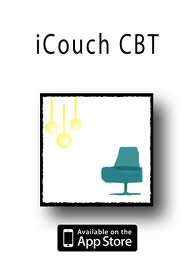 iCouch CBT (Cognitive Behavioral Therapy) -- love the allusion!!-- offers a step-by-step process by which you can change those negative, distorted thoughts (“I am the worst person in the whole world”) into more positive, not-so-distorted ones (“I may have my faults, but 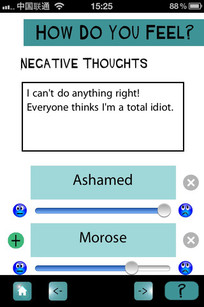 I am definitely a few steps above Charles Manson and ...”) If you are willing to part with some cash, you can upload your files to iCouch and a licensed psychologist will analyze how you are using the app and give you suggestions for improvement. 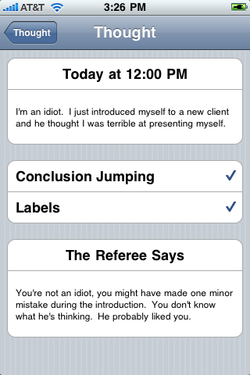 CBTReferee app CBTReferee runs on your iPhone, iPad, iPod Touch or Android device! You write down the thoughts in your head when they happen in order to catch flawed thinking and learn from it. You invent your own “referee” who gives you the fair take on each thought vs. a negative or biased view. When a completely unfair thought comes into your head, like "I'm an idiot," you don't just accept it as true. Whip out your phone, thumb it into the app and the referee will blow his whistle. Time out and the cheating team does not score the goal and bring you down!  Then there’s this app, which seems pretty far out there, way beyond left field. Brain Freqz purportedly works on the premise that mental states can be associated with brainwave frequency. For example, a person in a relaxed state may exhibit brain waves in the frequency range of 8 to 13 hertz. Brain waves in the frequency range of 1 to 3 hertz would indicate a state of deep, dreamless sleep. Certain frequencies are associated with healing and/or enhancing specific functions. The process of bringing your brain waves to specific frequency ranges is called “entraining.” BrainFreqz audio programs use various audio technologies including "isochronic tones," "monaural beats" and "binaural beats" to "entrain" brain waves. (I am not making this crap up!) The app maker claims that this practice is very useful for relaxing, becoming more focused, inducing sleep, etc... Current BrainFreqz offerings include Relaxation, Stimulation, Sleep, Headache Relief and Euphoria. (Wow, all for the low, low price of 99 cents! Talk about a cheap high! I want to get me a fix!) So, are we having fun yet? All this self-absorption! No wonder the world is going to hell in a flippin' handbasket! "People are hungry for stories. It’s part of our very being. Storytelling is a form of history, of immortality too. It goes from one generation to another."  Studs (courtesy Chicago Historical Society) "Work is about a daily search for meaning as well as daily bread, for recognition as well as cash, for astonishment rather than torpor, in short for a sort of life, rather than a Monday-to-Friday sort of dying.” 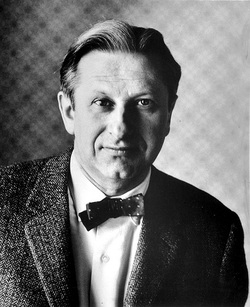 Studs: suave (courtesy Chicago Historical Society) "More and more we are into communications; and less and less into communication.” "Perhaps it is this specter that most haunts working men and women: the planned obsolescence of people that is of a piece with the planned obsolescence of the things they make. Or sell.” 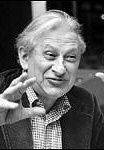 Louis "Studs" Terkel “I've always felt, in all my books, that there's a deep decency in the American people and a native intelligence -- providing they have the facts, providing they have the information.” And of course, his epitaph: "Curiosity never killed this cat."
Visit the Studs Terkel Centenary to hear recorded tributes (what else?!?!) to this amazing oral historian, the Chicago Historical Society archive for a gallery of his work, and a treasure trove of Studs at the New York Times. What we would do without you and your creations? They continue to inspire parodies and spin-offs from the ridiculous to the sublime. Here are just two (one has a slightly higher budget and production values): |
AuthorTo find out more about me, click on the Not Your Average Jo tab. Archives
February 2024
Categories
All
|
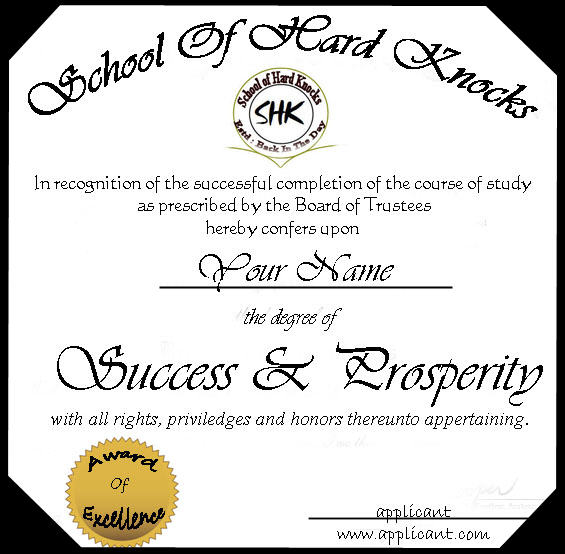
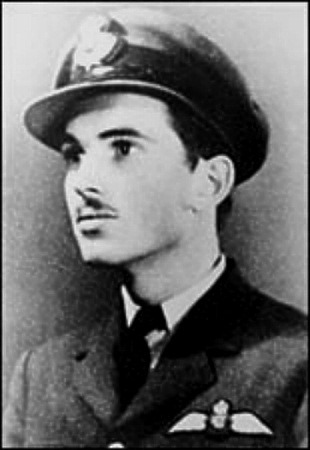
 RSS Feed
RSS Feed